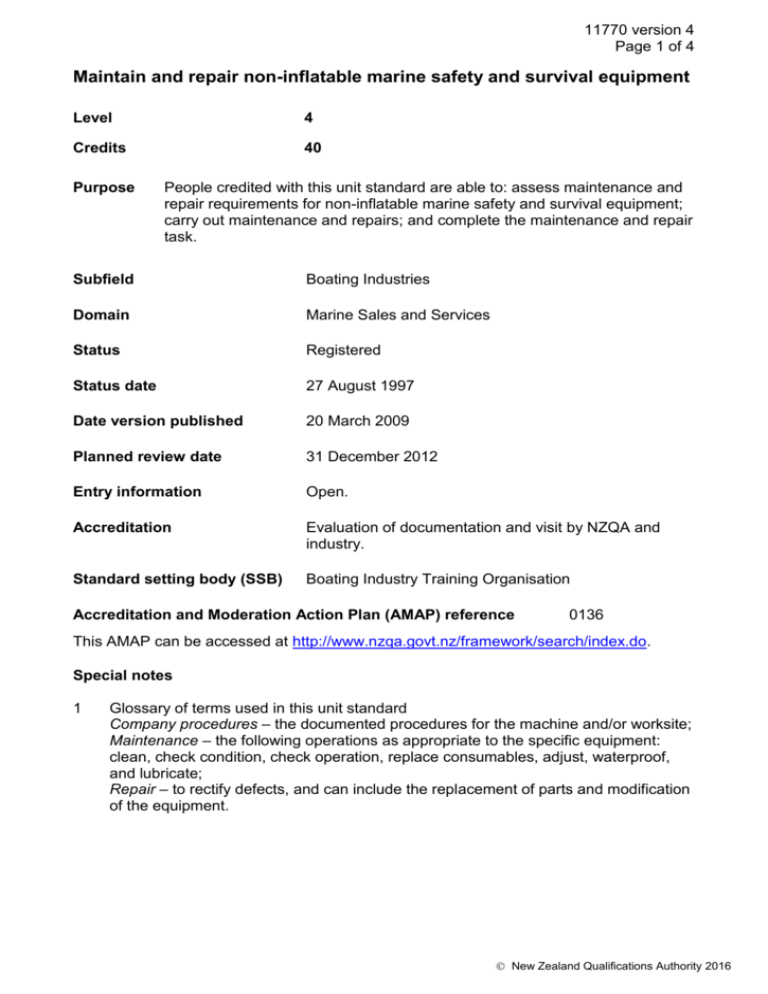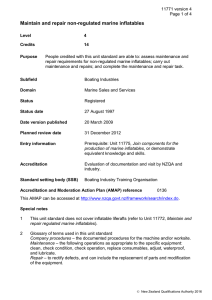11770 Maintain and repair non-inflatable marine safety and survival
advertisement

11770 version 4 Page 1 of 4 Maintain and repair non-inflatable marine safety and survival equipment Level 4 Credits 40 Purpose People credited with this unit standard are able to: assess maintenance and repair requirements for non-inflatable marine safety and survival equipment; carry out maintenance and repairs; and complete the maintenance and repair task. Subfield Boating Industries Domain Marine Sales and Services Status Registered Status date 27 August 1997 Date version published 20 March 2009 Planned review date 31 December 2012 Entry information Open. Accreditation Evaluation of documentation and visit by NZQA and industry. Standard setting body (SSB) Boating Industry Training Organisation Accreditation and Moderation Action Plan (AMAP) reference 0136 This AMAP can be accessed at http://www.nzqa.govt.nz/framework/search/index.do. Special notes 1 Glossary of terms used in this unit standard Company procedures – the documented procedures for the machine and/or worksite; Maintenance – the following operations as appropriate to the specific equipment: clean, check condition, check operation, replace consumables, adjust, waterproof, and lubricate; Repair – to rectify defects, and can include the replacement of parts and modification of the equipment. New Zealand Qualifications Authority 2016 11770 version 4 Page 2 of 4 2 Evidence of the elements of this unit standard must be presented across the following contexts: a equipment for both repair and maintenance – wet weather gear, man overboard equipment, signalling devices (other than radios), non-inflatable buoyancy aids, non-inflatable life rafts, hydrostatic releases, thermal protective equipment. Evidence is required for wet weather gear, man overboard equipment, signalling devices (other than radios), plus one further example. b equipment for maintenance only: fire protection equipment, emergency lights, emergency position indicating radio beacons (EPIRBs), first aid equipment. Evidence is required for fire protection equipment, plus one further example. 3 The following apply to the performance of all elements of this unit standard: a All required equipment must be set up, started up, operated, and shut down in accordance with company procedures. b All work practices must meet recognised codes of practice and documented worksite health and safety procedures (where these exceed code) for personal, product, and worksite health and safety, and must meet the obligations required under the Health and Safety in Employment Act 1992 and subsequent and delegated legislation. 4 This unit standard can be assessed off job. Elements and performance criteria Element 1 Assess maintenance and repair requirements for non-inflatable marine safety and survival equipment. Performance criteria 1.1 Inspection of the item establishes all maintenance and repair actions required to achieve fitness for purpose. 1.2 Maintenance and repair requirements are matched with manufacturer’s and/or regulatory requirements. Range maintenance schedules, allowable type and amount of repair. 1.3 Comparison of repair requirements with company's capability establishes requirements for outwork. 1.4 Maintenance and repair requirements are quantified in terms of the materials and time required. 1.5 Comparison of predicted maintenance and repair cost with the value of the item establishes the cost-effectiveness of the proposed maintenance and/or repair. New Zealand Qualifications Authority 2016 11770 version 4 Page 3 of 4 Element 2 Carry out maintenance and repairs. Performance criteria 2.1 Maintenance activities are carried out in accordance with manufacturer’s instructions and company procedures. 2.2 Repair methods are selected and carried out in accordance with manufacturer’s instructions and company procedures. 2.3 Repairs carried out restore items to operational fitness. 2.4 Maintenance and repairs are completed within agreed time-frames. Element 3 Complete the maintenance and repair task. Performance criteria 3.1 Equipment is tested to verify operational fitness in accordance with manufacturer’s instructions and company procedures. 3.2 Equipment is prepared for use, storage, and transit in accordance with company procedures. Range 3.3 sealing, packing, identification of shelf-life requirement. Documentation is completed in accordance with regulatory requirements, manufacturer’s requirements, and company procedures. Range labels, work cards, release notes, log books, service certification, regulatory certification. Please note Providers must be accredited by NZQA, or an inter-institutional body with delegated authority for quality assurance, before they can report credits from assessment against unit standards or deliver courses of study leading to that assessment. Industry Training Organisations must be accredited by NZQA before they can register credits from assessment against unit standards. Accredited providers and Industry Training Organisations assessing against unit standards must engage with the moderation system that applies to those standards. New Zealand Qualifications Authority 2016 11770 version 4 Page 4 of 4 Accreditation requirements and an outline of the moderation system that applies to this standard are outlined in the Accreditation and Moderation Action Plan (AMAP). The AMAP also includes useful information about special requirements for organisations wishing to develop education and training programmes, such as minimum qualifications for tutors and assessors, and special resource requirements. Comments on this unit standard Please contact the Boating Industry Training Organisation training@bia.org.nz if you wish to suggest changes to the content of this unit standard. New Zealand Qualifications Authority 2016











